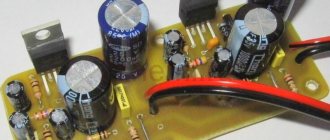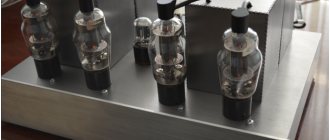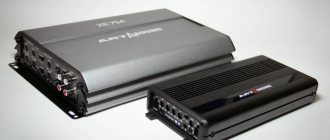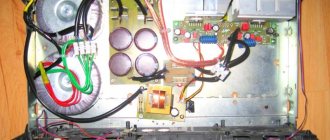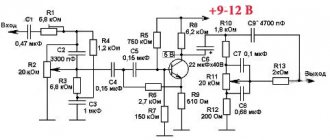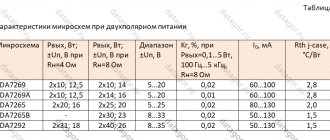We would like to dedicate this section to domestically produced audio equipment, which our country can be proud of. Typically, these components are mass-produced and can be purchased from the manufacturer or, at a minimum, made to order. The selection criterion is primarily sound.
The first to pass our tests was Mikhail Chumakov, a well-known development engineer from St. Petersburg, who gave his flagship power amplifier Filigrane FA5000 to the Stereo&Video laboratory.
Mikhail, how long have you been involved in audio?
I became interested in this at school, when at the age of 12 I built my first amplifier. Then there were student (cadet) years. Then, for the next 15 years, I conducted scientific research on information transmission and signal processing of space communication systems in a closed research laboratory. Since the late 90s, after defending my PhD thesis, more time has appeared, and the old love for audio has returned.
At this time, during the experiments, about a dozen amplifiers were created. An article about one of them was published in 2005 by Radio magazine. But despite the fact that the projects being created sounded better than industrial designs, dissatisfaction with the result remained. Only after a long scientific “siege” using the entire store of existing knowledge did the sprouts of future technology begin to appear.
In 2006, the first “Filigrane” was created - Filigrane FA 400. Six months later, a more powerful model FA 1000 was created. At the same time, the method of publishing the research results in the form of a finished serial product available to the end user was chosen.
Mikhail Chumakov in the workshop of Alexander Knyazev. With its signature horn speakers, the amplifier also passed all tests.
I know that many studio professionals really appreciate your amps. Why did you attract them so much? First of all, this is a focus on maximum reliability and accuracy of sound.
With minimal distortion. This is the main and main priority. At the same time, the choice of circuit design and element base is absolutely free from any conventions and fashion for ready-made recipes, of which there are plenty in the world of audio. However, distortions in the audio path are of a very different nature and, what is very important, vary greatly when perceived by ear.
We were able to identify the source of distortion, which becomes noticeable at levels of a thousandth of a percent or even lower. These distortions occur when nonlinear portions of the amplifier's response change location depending on the signal being amplified. Theoretically, this reduces the information throughput of the path, but in practice it causes a loss of transparency, sound detail and the appearance of a kind of “noise halo” around the sounding instruments.
The causes of such distortions may be thermal heating of semiconductors and “memory” effects in radioelements. For example, Lavardin uses the term memory distortion for them. Another source of such distortion is the current flowing through the speaker system. A modern amplifier supplies the output voltage to the speaker terminals very quickly, and the current through them is set according to a complex law within a few milliseconds in accordance with the magnitude and phase of the impedance.
The distortions that occur during the establishment of this current give that same “noisiness” to the sound image.
To instrumentally assess the presence of such distortions, we use the inverse intermodulation coefficient (RIMD). Without going into the technical details of its measurement (they are in the article on the website www.filigrane.ru), it is important to note that this coefficient very accurately reflects the correspondence between sound and measurements.
Compared to the studio amplifier models Filigrane FA400MkII and FA1000MkII, the new FA5000 model has the reverse intermodulation coefficient reduced by 5 (five!) times to the level of 0.0003%. Believe me, this difference is clearly audible.
Filigrane FA700 MkII
Modification of MkII 2022, aimed at reducing distortions affecting the spatial picture of the phonogram. As a result, it was possible to reduce the inverse intermodulation coefficient (RIMD) to 0.0003% (-110 dB) and thereby achieve phenomenal detail and transparency in the transmission of recording space.
- Provides 2x220W/8 Ohm and 2x350W/4 Ohm output power for working with mid-field monitors and, at the same time, perfectly handles the smallest details at very low power. This is achieved by ensuring the declared distortion characteristics in a wide range of levels - from the first milliwatt to the limit.
- Input attenuator (-15 dB) and smooth sensitivity adjustment (0...-16 dB) to match high-level sources.
- The amplifier is equipped with a “soft” start circuit, which eliminates inrush current consumption from the network when turned on, which significantly increases the reliability of its operation.
- Fully passive cooling with overheat protection. When the heat sink temperature rises above 100°C, the amplifier is disconnected from the network.
- The amplifier uses a built-in filter to cut off the DC component of the supply network. This eliminates the acoustic hum of the power toroidal transformer in the amplifier when the network is of poor quality.
- The electromagnetic relay is excluded from the speaker protection circuit. The protection circuit is made using a powerful triac, which significantly increased the reliability of the protection and eliminated possible distortion at the relay contacts. The protective functions remain the same: turn-on delay, from frequencies below 1 Hz, from direct voltages above 3 V, from short circuits in the load, from overheating of radiators.
- The model is equipped with a control input for an external trigger with a voltage of 5-30V for remotely turning on/off the power of the amplifier. The input is completely isolated from the housing and all internal circuits of the amplifier, which eliminates the formation of ground loops along the control circuits.
- Comes with removable brackets for installation in a 19″ rack.
Main technical characteristics
| | Nominal frequency range, Hz with uneven frequency response | |
| no more than 0.3 dB | 5…20000 | |
| no more than 3 dB | 2…65000 | |
| Voltage gain, dB | 27 (13*) | |
| Input impedance, kOhm | 30 | |
| Sensitivity, B | 1,23 (4,9*) | |
| Range of smooth sensitivity adjustment, dB | 0…-16 (-15…-31)* | |
| Maximum output power, W with harmonic coefficient no more than 0.7% | ||
| into an 8 Ohm load, STEREO mode (both channels work) | 2x220 | |
| into a 4 Ohm load, STEREO mode (both channels work) | 2x350 | |
| Harmonic distortion, %, at output power -50...-1 dB from maximum at frequencies | ||
| 1 kHz | 0,0007 | |
| 20Hz…20 kHz | 0,002 | |
| Inverse Intermodulation Ratio** (RIMD) 60Hz/6kHz 1:1, % | 0.0003 (-110 dB) | |
| Output resistance, Ohm | 0,016 | |
| 8 ohm load damping factor | 500 | |
| Connectors | ||
| Input: | 1/4″Jack, XLR (balanced) | |
| Weekend: | 30 A clamps | |
| Control | 1/8″Jack (3.5mm) | |
| Indication: power on, readiness for operation, clipping, protection triggered in channels. | ||
| Amplifier protection: from short circuit in the load, from overheating of radiators above 100°C | ||
| Acoustics protection: turn-on delay, from frequencies below 1 Hz, from DC voltages above 3 V | ||
| Cooling system | passive | |
| Dimensions, (WxDxH), mm | 485x415x130(3U) | |
| Weight, kg | 18 | |
| * Attenuator included | ||
| ** Inverse intermodulation coefficient (RIMD) is measured using the original method | ||
Filigrane FA700 Mk II power amplifier
The new version of the amplifier, created by a company from St. Petersburg, is distinguished by reduced distortion - both nonlinear and intermodulation. It’s good when developers have an understanding of how certain parameters affect the sound, as well as experience that allows them to improve these parameters. A project at the intersection of professional and home audio – that’s what makes it interesting.
Generally speaking, professional and home audio rarely overlap - they perform different tasks, which leads to differences in circuitry, construction and design. To voice public places (the so-called Public Address), first of all, you need power, reliability and increased resistance to climatic influences, and quality indicators can be considered last. The same can be said about concert equipment, the purpose of which is to create high sound pressure levels and the ability to operate in harsh temperature conditions. But there is still a narrow area in which the requirements of professionals and music lovers converge - studio equipment. It is in this niche that the laboratory of Mikhail Chumakov from St. Petersburg works - the amplifiers that it produces under the Filigrane brand are in all respects classified as Hi-Fi, but have a number of useful features for those who seriously work with sound.
The FA700 Mk II power amplifier is the second, improved modification of the model, released in 2022. It was originally intended to work with mid-field monitors, and the main goal of the improvements was to further reduce distortion measured using a “proprietary” method, which, according to the manufacturer, significantly improved the spatial picture during playback. The description says that the new version managed to reduce the inverse intermodulation coefficient (RIMD) to 0.0003% (-110 dB) and thereby “achieve phenomenal detail and transparency in the transmission of space.” This parameter is really important, but it is rarely indicated in the specifications. Let me remind you that intermodulation distortion arises due to the fact that signals with different frequencies, applied simultaneously to the input of the amplifier, generate a mass of combinational components. This always happens in music, and we perceive an increased amount of such “garbage” aurally as unnatural timbres and a lack of transparency at high frequencies. Unlike standard intermodulation measurement techniques, where signals with different frequencies are applied to the amplifier input, RIMD is measured by applying a second signal to the amplifier output in the form of current. This allows you to isolate the most “harmful” component of intermodulation distortion with a very low threshold of noticeability and, accordingly, concentrate on combating it.
The FA700 Mk II power amplifier is the second, improved modification of the model, released in 2022.
Thanks to the measures taken, with a fairly high output power (2x220W at eight ohms and 2x350W at four), the FA700 Mk II has very low distortion both at low volumes and at levels close to clipping.
To match with various signal sources, the amplifier has a switchable input level attenuator of -15 dB and smooth sensitivity adjustment within 0...-16 dB.
All inputs are balanced, XLR and 6.3 mm Jack.
The layout of the amplifier is symmetrical - a 600-watt toroidal transformer is installed in the center under the shielding cover, and the main printed circuit boards are mounted on the side heat sinks. There are four output transistors in each channel - two complementary pairs of Toshiba 2SC5200/2SA1943 in the shoulder. The power supply is provided by eight 10,000 uF x 100 V capacitors. The soft start circuit eliminates surge current consumed from the network when the amplifier is turned on, which has a positive effect on its reliability. The alternating supply voltage passes through a built-in filter that cuts off the direct component, which prevents the power transformer from humming when the network is overloaded.
There is no relay in the protection circuit, which eliminates possible distortion on the contacts and increases reliability.
There is no relay in the protection circuit, which eliminates possible distortion on the contacts and increases reliability. When turned on, the appearance of a frequency below 1 Hz or a constant voltage at the output of more than 3 V, as well as a short circuit in the load and overheating of the heat sinks, the output terminals are turned off by a powerful triac. Triggering of the protection is indicated by an LED on the front panel.
To remotely turn on/off the amplifier, a control trigger is provided that operates at a voltage of 5 - 30V. Its input is completely isolated from the housing and internal circuits, which eliminates the formation of ground loops along the control line.
The amplifier is equipped with removable brackets for installation in a 19-inch rack. Case height – 3U.
To test the amplifier, we chose three-way floor-standing speaker systems Solov'yev Sound SystemExperience V20. They have two 8-inch woofers, and the mid/high frequency section has a D'Appolito configuration, which promises the correct construction of the sound stage.
It is felt that the FA700 Mk II has a high damping factor, but it does not dry out the blow, but gives it clarity and speed.
But the first thing worth noting is that the amplifier confidently “holds” the acoustics, preventing it from relaxing. On the test recording, the drums sound as if they were alive, the impact is conveyed so naturally - with instant attack, energy filling, rich spectral components and long reverberations. When played, the kick drum has an almost real size; its subharmonics extend into the infra-low region. It is felt that the FA700 Mk II has a high damping factor, but it does not dry out the blow, but gives it clarity and speed. The bass has not only form, but also content - on rock music with an accented rhythm section, the system produces a real concert drive that energizes the listener. The piano is conveyed with the smallest timbral details; you can literally feel the response of its body. The cymbals are pure silver in a cloud of overtones. Dynamic contrasts (sharp transitions from barely audible sounds to peak tutti levels) are natural at any volume.
It's interesting how old records are perceived. Porgy & Bess performed by Ella Fitzgerald and Louis Armstrong, 1958 - the sound literally transports you to that era, the virtual images are surprisingly three-dimensional and physical.
I noted the amplifier’s ability to build a multifaceted sound space even earlier, when I listened to other Solov’yev Sound System-Pentanon speakers with it. With the Experience V20 it turned out even more interesting: some of the instruments went back, some moved forward, and the systems themselves, despite their substantial dimensions, simply disappeared from the sound field on some phonograms. And even with a wide stereo base, there was no feeling of a rarefied atmosphere; the space was always densely filled. The number of plans in depth will depend on the recording itself, but in any case the amplifier will show them all. On Summertime, for example, there are three of them: vocal parts and trumpet in front, double bass behind and drums about one and a half meters behind the front line, and the orchestra serves as the background for the whole picture.
Dynamic contrasts (sharp transitions from barely audible sounds to peak tutti levels) are natural at any volume.
The overall dynamics also give no reason for criticism; with a speaker sensitivity of 89 dB, the amplifier is capable of producing a sound pressure that literally presses you into your chair. At the same time, there is no noticeable distortion, coloration, or disturbances in the sound stage.
The FA700 Mk II is an honest professional that doesn't bring anything to the sound, but doesn't hide anything either. You can listen to it at home at a comfortable volume, and confidently voice a small hall with the same quality. Yes, the design is modest, but the new product from Filigrane is attractive because the efforts of its creators were focused on reliability and sound quality.
MUSIC
- Dali, “In Admiration of Music. Volume 4". Dali CD, 2015
- Dream Theater, "Falling Into Infinity". EastWest Records, 1997
- Sweetbox. BMG/RCA, 1998
- Ella Fitzgerald & Louis Armstrong, "Porgy & Bess". Verve, 1958
- Jean Sibelius "Violin Concerto". Anne-Sophie Mutter &Staatskapelle Dresden. Deutsche Grammophon, 1995
COMPONENTS
- Sources: Pioneer DV-LX50 DVD player, MacBook with Amarra 4 Luxe player
- USB DAC M2Tech Evo
- Preamplifier Filigrane FD17
- Speaker systems: Solov'yev Sound SystemExperience V20
Filigrane FA700 Mk II
Manufacturer: Filigrane Audio (Russia)
filigrane.ru
Inputs: Jack ¼, XLR || Output power: 2 x 220 W (8 ohms), 2 x 350 W (4 ohms) || Frequency Range: 2 Hz – 65 kHz (+/-3 dB) || Gain: 27 (13) dB || Nominal sensitivity: 1.23 (4.9) V || Sensitivity adjustment range: 0 – -31 dB || Input impedance: 30 kOhm || Signal-to-noise ratio: -110 dB || Maximum peak output current: 2 x 60 A || Distortion level in the power range -50 ... -1 dB: 0.0007% (1 kHz), 0.002% (20 Hz - 20 kHz) || Reverse Intermodulation Ratio (RIMD) 60Hz/6kHz 1:1: 0.0003% || Output Impedance: 0.016 Ohm || Damping factor: 500 || Dimensions: 485 x 415 x 130 mm || Weight: 18 kg || Price: 95,000 rub.
Filigrane amplifiers can be listened to at the Round Audio office
share
Tags: FiligraneFiligrane FA700 Mk II

